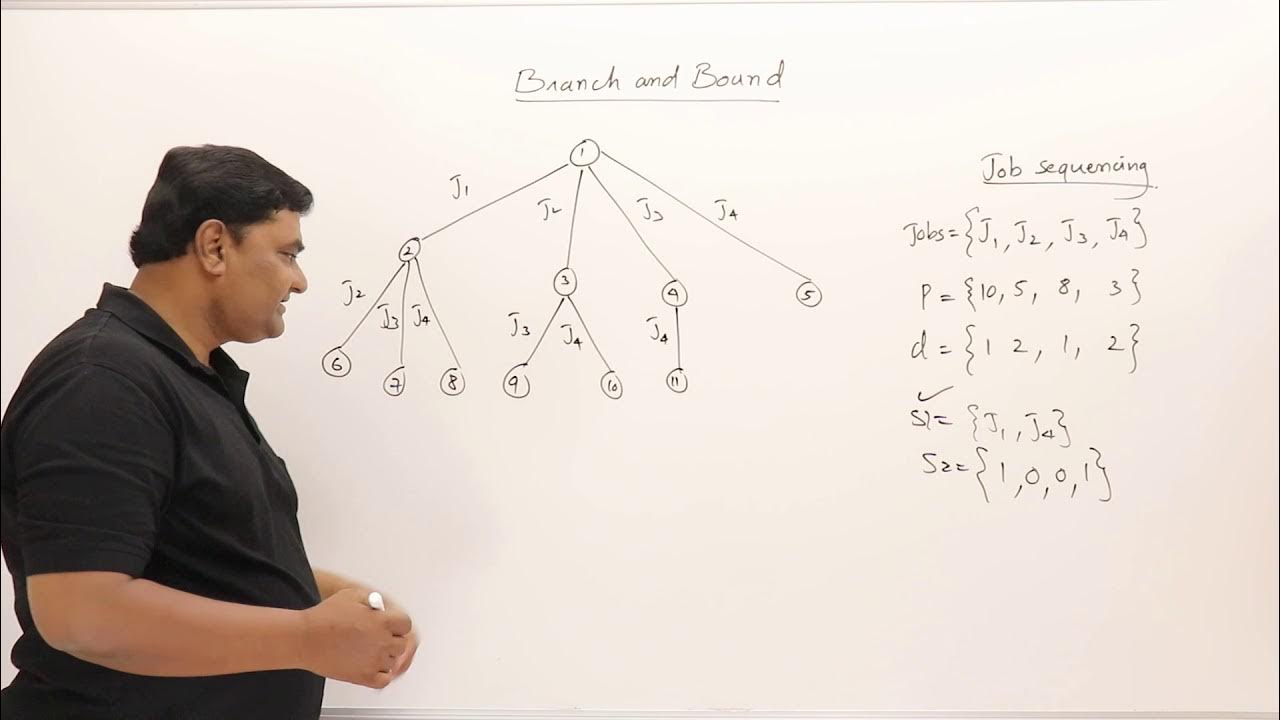Branch & Bound Algorithm with Example | Easiest Explanation of B&B with example
Summary
TLDRIn this video, the Branch & Bound algorithm is explained in detail. This optimization method finds the best solution by breaking down problems into subproblems (branching) and eliminating non-promising paths (bounding). The process involves calculating and comparing costs of various solutions, pruning the higher-cost paths, and continuing with the least expensive options. Using a simple graph example, the video demonstrates how the algorithm progressively finds the optimal solution by exploring partial paths, pruning inefficient ones, and ultimately reaching the goal with the minimum cost. It's an essential approach for solving complex optimization problems.
Takeaways
- 😀 Branch & Bound is an algorithm used to find the optimal solution to a problem by exploring sub-solutions and eliminating non-optimal paths.
- 😀 The term 'Branch' refers to extending a problem into sub-problems or partial solutions, while 'Bound' involves ignoring paths that are worse than the current best solution.
- 😀 The process involves evaluating multiple paths and pruning those that exceed the cost of the current best solution.
- 😀 The algorithm starts with a state and aims to reach a goal state by exploring the least costly paths first.
- 😀 At each step, the algorithm checks the cost of extending the current path and chooses the one with the minimum cost.
- 😀 Pruning occurs when a partial solution's cost is higher than the best solution found so far, ensuring the algorithm only explores promising paths.
- 😀 The algorithm can involve backtracking, where the search revisits previous states to explore alternative solutions if necessary.
- 😀 A key aspect of Branch & Bound is that it evaluates partial solutions and removes non-optimal ones early to reduce unnecessary exploration.
- 😀 The algorithm involves examining options at each node and extending the one with the minimum cost, while ignoring paths that cost more.
- 😀 The final optimal solution is the one with the least cost to reach the goal, which is found by comparing all possible paths and pruning the higher-cost ones.
Q & A
What is the Branch & Bound algorithm used for?
-The Branch & Bound algorithm is used to find the optimal solutions to problems, particularly in combinatorial optimization tasks, by exploring possible solutions and pruning non-optimal ones.
How does the 'Branch' part of the Branch & Bound algorithm work?
-The 'Branch' part involves generating subproblems or sub-solutions by extending the current problem into smaller sub-problems, essentially branching out to explore different paths.
What does 'Bound' refer to in the Branch & Bound algorithm?
-In the Branch & Bound algorithm, 'Bound' refers to eliminating partial solutions that cannot be better than the current best solution. It helps in pruning branches that exceed the cost or time of the optimal solution.
What is the main goal of the Branch & Bound algorithm?
-The main goal of the Branch & Bound algorithm is to find the optimal solution by exploring all possible paths while pruning branches that cannot provide a better solution than the current best.
What is the search strategy used in Branch & Bound?
-The search strategy in Branch & Bound involves extending the cheapest partial path first, and if any path exceeds the current best solution, it is pruned.
Why do we prune certain paths in the Branch & Bound algorithm?
-Paths are pruned when they are found to have a higher cost than the current best solution. This helps reduce unnecessary computations and ensures that only promising paths are explored further.
Can you explain the steps in the example provided in the script?
-The example starts with state S, where the algorithm explores two options (A and B). From the cheapest path (S → A), the algorithm further explores state D, then E, and eventually reaches the goal state G. The optimal path found has a total cost of 8.
What is the significance of pruning paths that exceed the current best solution?
-Pruning such paths is crucial as it prevents the algorithm from wasting time on suboptimal solutions that are unlikely to lead to a better result, thus improving efficiency.
What is meant by a 'leaf node' in the context of Branch & Bound?
-A 'leaf node' refers to a node that has no further branches to explore, meaning it is a final step in a possible solution path. It represents a partial or complete solution.
How does the algorithm ensure that the optimal solution is found?
-The algorithm ensures that the optimal solution is found by continuously extending the cheapest partial path and pruning paths that are more costly than the current best solution. This process continues until no better solution exists.
Outlines

This section is available to paid users only. Please upgrade to access this part.
Upgrade NowMindmap

This section is available to paid users only. Please upgrade to access this part.
Upgrade NowKeywords

This section is available to paid users only. Please upgrade to access this part.
Upgrade NowHighlights

This section is available to paid users only. Please upgrade to access this part.
Upgrade NowTranscripts

This section is available to paid users only. Please upgrade to access this part.
Upgrade NowBrowse More Related Video

L-4.5: Deadlock Avoidance Banker's Algorithm with Example |With English Subtitles

FIUBA. Teoría de algoritmos 1. Búsqueda Exhaustiva - Branch & Bound: Problema de la mochila

L-4.13: Bellman Ford Algorithm | Dijkstra's Vs Bellman Ford | Single Source Shortest Path

7 Branch and Bound Introduction

K-means Clustering dengan Excel

#12 First Come First Serve (FCFS) Scheduling Algorithm Explained | Non-Preemptive CPU Scheduling
5.0 / 5 (0 votes)